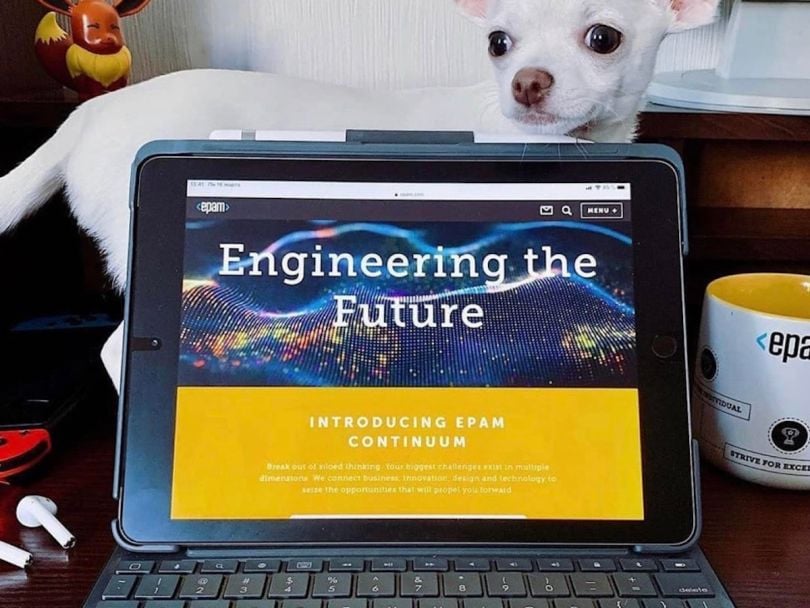Remote work matters. It’s also changing. At EPAM Systems, SVP and Chief People Officer Larry Solomon has his finger on the pulse of remote work’s evolution, as well as the technologies and systems that are helping employers achieve new levels of digital collaboration, efficiency and security.
Solomon is responsible for overseeing all aspects of talent management, talent acquisition, workforce planning and management, as well as other human resource related functions within EPAM globally. Prior to joining EPAM, he held a number of leadership positions at Accenture and was also the global COO of human resources for nearly three years, with overall responsibility for human resources operations.
Built In is thrilled to have Solomon lend his expertise and contribute to this Insider Spotlight about EPAM Systems, remote work and EPAM’s Remote By Design™ approach.

Remote work is not a novel or recent development. Nevertheless, the pandemic — and the accelerated adoption of technology solutions, like video conferencing — transformed people’s perspective of what constituted the “workspace.” Today, around 56 percent of companies continue to embrace completely remote or hybrid work.
Of course, business leaders have their concerns, be it the well-being and productivity of employees, maintaining corporate culture, or hiring and retaining new talent. Whether or not this new workplace model is superior to the past, one thing is certain — remote work is here to stay.
It’s up to business leaders to properly navigate new challenges and capitalize on emerging opportunities.
Key Advantages and Disadvantages of Remote Work
The benefits and difficulties of remote work often depend on the employee. However, for the most part, people find that working from home gives them enormous flexibility to sleep in or wake up early, cook more homemade meals, help children with homework, focus more on assignments, get chores done easier — the list goes on and on. Remote work can also reduce stress; people, for instance, can dress more comfortably. Remote work also brings the added bonus of less automotive travel, resulting in environmental benefits with reduced emissions and fossil fuel consumption. Furthermore, removing workplace commutes is an incredible time-saver: It allows remote employees to save an average of 40 minutes every day.
On the other hand, there are several disadvantages — namely, the work environment element. The lack of face-to-face interactions can decrease employee motivation and buy-in to company culture. Moreover, as the thin work-life veil vanishes, people struggle to create manageable schedules, collaborate effectively or find the willpower to meet deadlines. Technical issues are also harder to resolve via computer, especially when the computer doesn’t work.
“If a model or method works — and also outshines the competition — brands should emulate it. EPAM is such an example.”
EPAM: 2021 Best Places to Work
For tech companies, it’s important not to waste time and energy attempting to reinvent the wheel. If a model or method works — and also outshines the competition — brands should emulate it. EPAM is such an example.
Named “2021 Best Places to Work” by Built In, EPAM worked to support its people throughout the height of the pandemic and into today’s fluctuating market conditions. It provides comprehensive employee benefits, including competitive compensation, ample opportunities for professional development, upskilling programs and backing for personal passions via volunteer work and purpose-driven hackathons.
Built In’s “Best Places to Work” award winners had to exhibit a commitment to creating meaningful cultures and, more importantly, meeting talent needs in a dynamic landscape. EPAM demonstrated this through its unique Remote By Design™ approach. EPAM is a veteran enabler of dispersed workers with more than 60,000 global employees working remotely across more than 50 countries and nearly 29 years of refining collaborative, productive and secure remote working practices. In fact, its Remote By Design™ solution has undergone over 24 months of rigorous testing, making it ideal for any tech company looking to enhance its current remote setup.

EPAM’s Remote By Design™ Approach
In 2020, 94 percent of the Fortune 1000 experienced supply chain disruptions due to the pandemic. Although such issues aren’t as severe now, many problems and challenges still linger for tech companies attempting to find a rhythm. Tech brands need to optimize their hybrid or fully remote teams, practices and technology solutions to consistently deliver in these uncertain times.
“EPAM also helps clients blend their internal and external staff in multifunctional streams, permitting global collaboration.”
EPAM’s Remote By Design™ solution and world-class engineering capabilities empower businesses to rapidly build flexible and scalable operating models or transform and enhance their existing digital platforms. EPAM also helps clients blend their internal and external staff in multifunctional streams, permitting global collaboration. Likewise, EPAM’s solution can enable adaptive productivity monitoring and performance management through natively built desktop and laptop tools and data collection capabilities.
It’s also worth noting that an unavoidable consequence of remote settings is the expansion of the potential targets for hackers to exploit. Laptops, for example, are now an entry point into the corporate network. Indeed, the WHO reported a five-fold increase in such attacks during the pandemic. Thankfully, EPAM’s approach offers a Remote Cybersecurity Assessment, an invaluable resource during this age of heightened cyberattacks.

Time to Go All In
Today, tech organizations embracing remote or hybrid work must think about long-term business strategy. Similarly, the struggles and challenges restricting employees won’t resolve themselves over time — brands need to streamline inefficient remote processes to attract new talent and overcome burnout. With EPAM’s expert consulting, engineering and managed services, tech companies can continue to unabashedly embrace remote work, providing immense benefits to both their employees and their bottom line.





